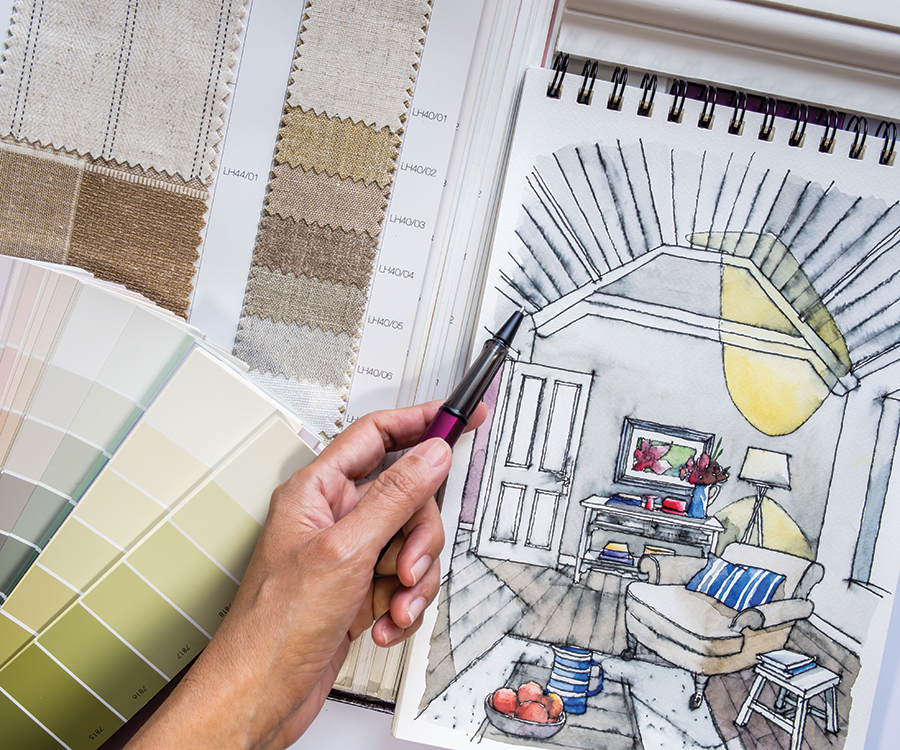Becoming an interior designer requires creativity and a keen eye for detail. It’s a mix of art, design, and functionality.
Interior design is more than just decorating rooms. It’s about creating spaces that are both beautiful and functional. Whether you’re starting from scratch or looking to improve your skills, this guide will help you on your journey to becoming an interior designer.
From understanding color theory to learning about different materials and styles, there are many aspects to explore. You’ll also need to develop your communication skills to work with clients and contractors. Ready to dive into the world of interior design? Let’s get started!
Credit: www.markeluk.com
How to Be an Interior Designer in 2025
Dreaming of a creative, rewarding, and impactful career? Becoming an interior designer could be your perfect path. Whether you want to work for a top firm, launch your own business, or freelance, here’s a modern, step-by-step guide to help you start and thrive in the interior design industry.
Step-by-Step Guide to Becoming an Interior Designer
-
Earn a Degree or Certificate:
Most interior designers hold a bachelor’s degree in interior design or a related field. Accredited programs teach architecture, design theory, color, lighting, textiles, and business. If you already have a degree, consider a certificate program to build your foundation.
Tip: Choose a program accredited by the Council for Interior Design Accreditation (CIDA). -
Gain Professional Experience:
Complete a supervised internship or entry-level job at a design firm, architecture office, or as a design assistant. This hands-on experience is essential for building skills and meeting licensure requirements. -
Pass the NCIDQ Exam (or State Equivalent):
Most states require passing the National Council for Interior Design Qualification (NCIDQ) exam to become a licensed interior designer. This exam covers design, codes, project management, and ethics. -
Build a Strong Portfolio:
Collect your best work-sketches, mood boards, CAD drawings, and photos-into a professional portfolio. A strong portfolio is crucial for landing jobs or clients and showcasing your unique style. -
Get Hired or Start Your Own Firm:
You can work for a design firm, architecture company, or start your own business. Many designers eventually launch their own studio or work as freelancers. Networking and building your reputation are key to success. -
Continue Learning & Stay Updated:
The best interior designers keep learning-attend workshops, earn advanced certifications, and stay current with design trends, sustainability, and new technology.
Top 3 AI Tools for Interior Designers
User-friendly platform for creating detailed 2D and 3D interior layouts. Drag and drop furniture, experiment with color schemes, and visualize your designs before you build.
Web-based design tool with real-time 3D rendering, smart layout suggestions, and a wide catalog of furnishings. Perfect for visualizing and planning every room in your home or for clients.
Professional-grade software for photorealistic interior designs, floor plans, and instant project quotes. Ideal for interior designers planning high-end projects or collaborating with contractors.
- Earn a Degree or Certificate: Council for Interior Design Accreditation (CIDA)
- Pass the NCIDQ Exam: National Council for Interior Design Qualification (NCIDQ)
Introduction To Interior Design
Interior design means making rooms look good and work well. It combines art and science to improve a space. Designers pick colors, furniture, and decorations. They also plan how to use the space best. It can be for homes, offices, or other buildings. Each place has its own needs and style. Designers listen to what clients want. They then create designs that match those wishes.
Good interior design makes a place feel comfortable and stylish. It helps people feel happy and relaxed. Well-designed spaces are also practical. They make it easy to move around and use the space well. In offices, it can boost work productivity. In homes, it makes living more enjoyable. Good design can also add value to a property. Attractive spaces are more appealing to buyers.
Essential Skills
Developing creativity and a keen eye for detail is essential for becoming an interior designer. Strong communication skills are also crucial to understand client needs and present ideas effectively. Additionally, knowledge of color theory and space planning is vital for creating beautiful, functional spaces.
Creativity And Imagination
Being an interior designer needs a lot of creativity. You must think outside the box. Imagine new ways to use space. Colors and textures play a big role. Combine them in unique ways. Use your imagination to create beautiful rooms. Every project is different. Bring fresh ideas to each one.
Technical Knowledge
Technical skills are also very important. Understand building codes and safety rules. Know how to read blueprints. Work with architects and builders. Use design software to create plans. This helps you show clients your ideas. Keep learning new tools and technologies. This will make your job easier and more efficient.
Educational Pathways
Aspiring interior designers can start by earning a degree in interior design. Practical experience through internships and projects is essential. Building a strong portfolio showcases your skills to potential clients.
Degree Programs
Many interior designers start with a degree. A bachelor’s degree in interior design is common. Some choose to get an associate degree. These programs teach design principles. Students learn about color theory. They also study space planning and materials. Internships are often part of the program. They give real-world experience. Students can build a portfolio. This helps them find jobs after graduation.
Certification And Licensing
Certification is important for interior designers. Many states require a license. To get certified, one needs to pass the NCIDQ exam. The National Council for Interior Design Qualification offers this exam. It tests design knowledge and skills. Some states have additional requirements. Continuing education is often needed. This keeps skills up-to-date. Certified designers can use the title “Registered Interior Designer”. This can help in finding clients and jobs.
Building A Portfolio
A digital portfolio is key. It shows your best work. Clients can see your style. Use high-quality photos. Each photo should tell a story. Add descriptions. Describe your choices. Explain the materials and colors. This helps clients understand your vision.
Show your unique style. Use different projects. Include homes, offices, and shops. Show variety. Use different themes. Modern, rustic, or classic. This shows your range. Clients look for different styles. Make your portfolio diverse.
Understanding Client Needs
Talking to clients helps to understand their needs. Ask about their likes and dislikes. Find out their favorite colors and styles. Take notes. These details help create a unique design. Building trust during interviews is key. Clients should feel heard and valued.
Use the information from interviews to create a design plan. Sketch ideas on paper first. Then use design software to make it look real. Show clients your sketches and digital designs. Get their feedback. Make changes if needed. Keep the client involved in every step. This ensures the final design matches their vision.
Design Principles
Balance is key in design. Symmetry helps create calm. Asymmetry adds interest. Use both for best results. Harmony ties the room together. Similar colors and textures help. They make the space feel whole. Avoid too many contrasting elements. They can make the room feel chaotic.
Color sets the mood. Warm colors feel cozy. Cool colors feel calm. Choose colors that match the room’s purpose. Texture adds depth. Soft textures make spaces feel cozy. Rough textures add interest. Mix textures for a balanced look.
Staying Updated With Trends
Reading design magazines helps you know the latest trends. These magazines show new styles and ideas. They also feature famous designers. This can inspire your own work. Some popular magazines are “Elle Decor” and “Architectural Digest.” Try to read them regularly. This will keep your ideas fresh.
Attending industry events is crucial. These events include fairs and exhibitions. They showcase new products and designs. You can meet other designers and learn from them. Events like “Salone del Mobile” in Milan are very popular. They help you stay connected to the design community.

Credit: www.youtube.com
Marketing Your Services
Creating a website is key. It shows your portfolio and skills. Use social media to share your work. Instagram and Pinterest are great. Post regular updates. Share before and after photos. Write blogs about design trends. Engage with followers. Answer their questions. This builds trust and connection.
Attend industry events. Meet other designers and contractors. Join local groups or online forums. Share tips and advice. Offer help when you can. Build relationships. These connections can lead to new clients. Collaborate on projects. This expands your network. It’s mutually beneficial.

Credit: www.417mag.com
Frequently Asked Questions
What Skills Are Needed To Be An Interior Designer?
To be an interior designer, you need creativity, knowledge of design principles, excellent communication, and problem-solving skills. You should also be proficient in design software and have a keen eye for detail.
How Do I Start A Career In Interior Design?
Start by earning a degree in interior design. Gain experience through internships and build a portfolio. Networking and joining professional organizations can also help you establish a career in interior design.
What Is The Role Of An Interior Designer?
An interior designer plans and designs interior spaces. They create functional, safe, and aesthetically pleasing environments by selecting furniture, colors, lighting, and materials. They also collaborate with clients and contractors.
Is Certification Necessary For Interior Designers?
Certification is not always mandatory but can enhance your credibility. Certifications from organizations like NCIDQ demonstrate your expertise and commitment to the profession.
Conclusion
Becoming an interior designer requires creativity and a keen eye for detail. Start with basic design principles and practice regularly. Learn from experienced designers and stay updated with trends. Build a strong portfolio showcasing your unique style. Networking is crucial; connect with industry professionals.
Keep enhancing your skills through courses and workshops. Passion and dedication will guide your journey in this rewarding career. Now, you’re ready to bring beautiful spaces to life!

My name is Mahi Uddin, and I’m a blog writer with over two years of experience specializing in creating engaging, informative content using AI tools. I contribute to InExDecor.com, where I share creative ideas and practical tips for transforming interior and exterior spaces into beautiful, functional environments. With a passion for storytelling and a knack for blending creativity with technology, I strive to craft blogs that not only inform but also inspire readers. When I’m not writing, you can find me exploring design trends or enjoying a good book with a cup of coffee.








